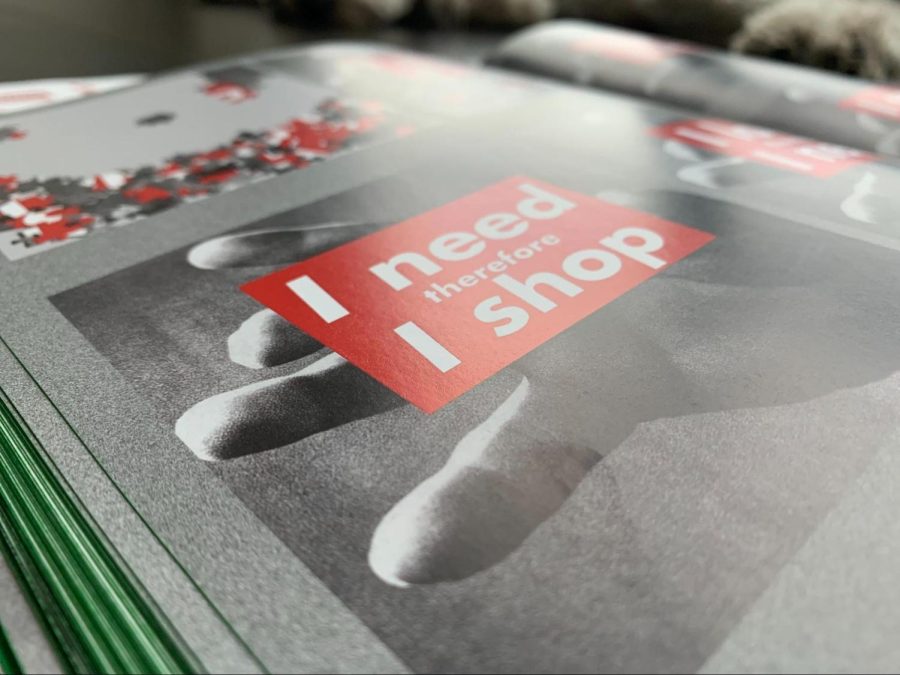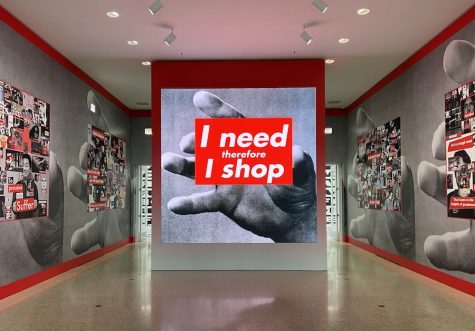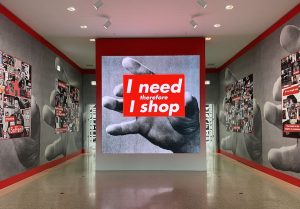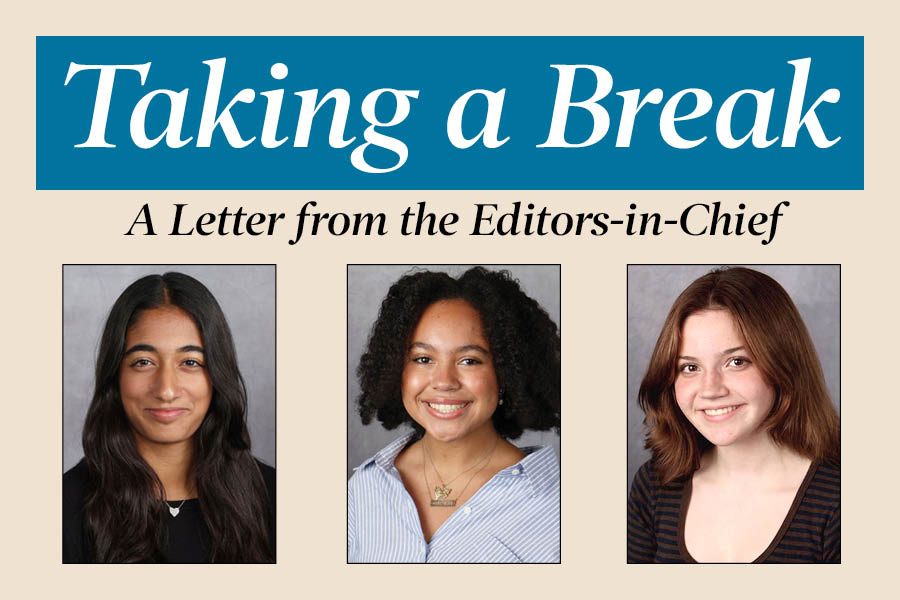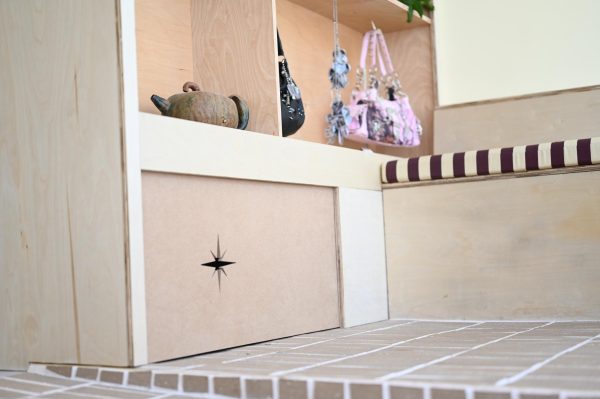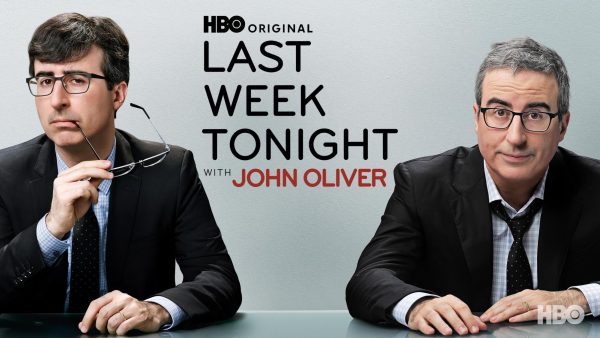Supreme Swipe: Supreme logo spurs ethics controversy
A page from Eleey Farrell and Govan Norse Rondeau’s book on Barbra Kruger’s exhibit at the Art Institute Of Chicago: “Thinking of you I mean me I mean you.” The statement,“I need therefore I shop” is a still from the video version of “Untitled (I shop therefore I am), 1987/2019.” The phrase is a play on Rene Descartes’ philosophical concept “I think, therefore I am” with a classic Kruger twist. Ms. Kruger is known for social commentary on consumerism and these stills demonstrate the irony in the Supreme Swipe.
May 20, 2022
Universal ethics consist of certain repeated truths: kindness, honesty and to never claim something that isn’t yours.
Student artist Keira Harter opens her phone to an Instagram “call out” post. This is nothing out of the ordinary, as users are constantly being reprimanded for problematic behavior online. This time, an art account is being accused of lifting work that isn’t theirs. Support is rallied for the original creator, as no one would side with a stealer. But how does the community react when the perpetrator is Supreme, a brand worth over a billion dollars?
The lifting of the work of artist Barbara Kruger as the face of the Supreme brand without permission, is not only a debate of ethics but one of consumerism and clout.
Streetwear has its origins in ’90s surfing, skating and hip-hop culture. Often, these groups didn’t wear designer brands but established their own, more accessible fashion trends.
According to brand-sharing platform Vocast, streetwear was about the artist and creative expression and less about an overnight trend.
“90’s graphic tees, loose-fitting jeans, and statement sneakers were created purposefully as an expression by their consumer: the rapper, the skater, and the rebel,” the publication said.
Supreme and other streetwear brands have taken the idea of accessible fashion and turned it on its head, moving the needle further away from the ideals present in the ’90s. In Episode 5 of Patriot Act with Hasan Minhaj, hip-hop and skater culture followers are now willing to pay for higher-priced items so long as they still represent streetwear, which creates a mix of streetwear and high fashion.
Through collaborations, Supreme has turned itself into more than a box logo. Mr. Minhaj goes on to define the term “Supremium”: energy built around Supreme product drops and resale value.
“Because Supreme drops sell out immediately, people have to buy it on secondary markets, and Supreme items become even more expensive on the resale market,” Mr. Minhaj said. “Resellers call this the ‘Supremium.’”
As the brand continued to grow in popularity and featured more collaborations with high end brands, viewers began to recognize the iconic box logo as being the work of graphic designer Barbara Kruger. Sunny Neater, a Laboratory Schools art teacher, said she noticed immediately.
“When I first saw the supreme logo, I was like, ‘Oh, damn, OK. They’re not shy about totally taking Barbara Kruger’s artwork and idea,’” Ms. Neater said.
Ms. Kruger’s work stems from her background as a graphic designer. The cut-and-paste style of her work makes it easily recognizable and similar to newspaper and magazine design.
Even with the clear ethical problems of taking the work of another artist, Ms. Neater was further shocked by the way Supreme utilized an anti-consumer, anti-capitalist, feminist artist to take from, given their brand was none of those things.
“I just thought it was ironic that Supreme would just basically copy all of her branding identity, to represent something that was so antithetical to her artwork,” Ms. Neater said. “From every angle to approach Supreme, it seemed like they were trying to do everything opposite that she represented in her work.”
According to Mr. Minhaj’s Patriot Act, Ms. Kruger’s response to Supreme was less than angry. In response to a request for comment on Supreme’s lawsuit with another company using a similar logo, Ms. Kruger had few words.
“She sent a blank email with a single attachment that said ‘What a ridiculous clusterf— of uncool jokers,’” Mr. Minhaj said.
Ms. Neater found Ms. Kruger’s response to be effective and in line with her aesthetic.
“[It’s] like the ultimate flex like, I don’t even care about you guys. Like, really y’all are so silly,” Ms. Neater said.
One of the biggest ways Ms. Neater tries to combat situations like this is by teaching her students to take inspiration without lifting.
It’s important to go off on your own and develop your own style and your own sense of anatomy and design.
— Keira Harter
“[I] show them what other people have done, how other people have used this medium, not as an example of what you should do, but as an example of how people think,” Ms. Neater said.
Keira believes tracing and directly copying isn’t a good way to learn and develop your own style as an artist. She encourages beginners to experiment to be more successful.
“It’s important to go off on your own and develop your own style and your own sense of anatomy and design,” she said.
Despite this, Ms. Neater understands the difficulty in developing your own style due to the human condition.
“Visual culture is just like a sea around us,” she said, “and it’s hard not to take what we see and incorporate it into our own ideas. Especially if what we see really resonates with what we’re thinking and feeling for our own work.”



